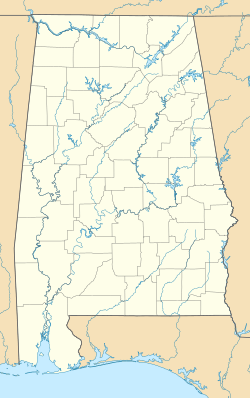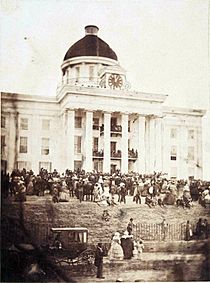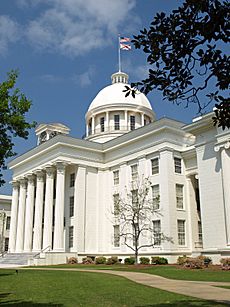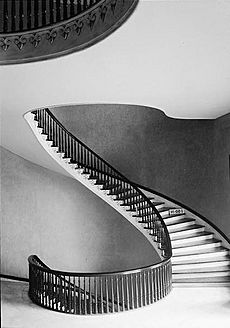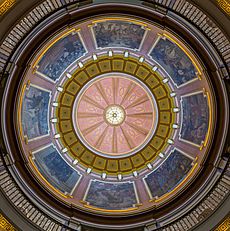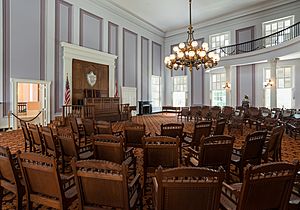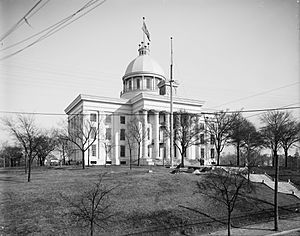Alabama State Capitol facts for kids
|
First Confederate Capitol
|
|

The Alabama State Capitol in 2016
|
|
| Location | Montgomery, Alabama |
|---|---|
| Built | 1851 |
| Architectural style | Greek Revival |
| NRHP reference No. | 66000152 |
Quick facts for kids Significant dates |
|
| Added to NRHP | October 15, 1966 |
| Designated NHL | December 19, 1960 |
The Alabama State Capitol is a very important building in Montgomery, Alabama. It's where the state's government leaders work. This building is also known as the First Confederate Capitol because of its role in history. It sits on a hill that used to be called Goat Hill.
Even though it's the official capitol, the Alabama Legislature (the group that makes laws) doesn't meet here anymore. They meet in a different building nearby called the Alabama State House. Today, the Capitol building holds the governor's office and works mostly as a museum.
Alabama has had five different capital cities and four special buildings for its government. The first capital was St. Stephens in 1817. Then, Huntsville was the capital in 1819. Cahaba became the first permanent capital in 1820. In 1826, the capital moved to Tuscaloosa. A new three-story building was built there.
Finally, in 1846, the state government moved to Montgomery. The first capitol building in Montgomery burned down after only two years. The building you see today was finished in 1851. More parts were added over the next 140 years. These changes happened as more people moved to Alabama. Many European-American settlers who owned enslaved people arrived. Large areas of the state were then used to grow cotton.
The current Capitol building was briefly the capital for the Confederate States of America in 1861. This was before Richmond, Virginia became their main capital. Leaders met in the Senate Chamber here. They wrote the first laws for the Confederate States on February 4, 1861. They also approved the final laws on March 11, 1861.
Contents
What the Capitol Looks Like
The Capitol building has a Greek Revival style. This means it looks like ancient Greek temples. It also has some Beaux-Arts influences, which is a fancy style from the late 1800s. The main part of the building and the back wing have three floors. The side wings have two floors. The front of the building is about 350 feet (107 meters) wide. It is about 119 feet (36 meters) tall from the ground to the top of the dome.
History of the Capitol Building
First Capitol in Montgomery
The first capitol building in Montgomery was designed by Stephen Decatur Button. Andrew Dexter Jr., one of Montgomery's founders, saved a good piece of land for the capital. This land, on Goat Hill, was chosen for the new building. Construction started in 1846. The building was finished and given to the state on December 6, 1847.
This first building was made of brick covered in stucco. It had two full stories and a raised basement. A large front porch with six columns was in the middle. A dome, 40 feet (12 meters) wide, sat on top. This first capitol building sadly burned down on December 14, 1849. This was just over two years after it was finished. The ruins were cleared away by March 1850. A new building was planned right after.
Current Alabama State Capitol
The current Alabama State Capitol is the sixth government building in Alabama's history. It's the second one built in Montgomery. It was built from 1850 to 1851. Barachias Holt was the main architect and builder. He was a skilled craftsman from Maine.
The new building used the old brick foundations and the general shape of the first building. Holt made some changes. He made the building taller, with three full stories. The front porch also had three stories with special columns. Holt's dome was different too. It was made of wood and cast iron. It had a ring of Corinthian columns and a simple top with twelve glass windows.
The new Capitol building was first used by the Alabama Legislature on October 1, 1851. The clock over the front porch was put in four months later, in February 1852. The city of Montgomery bought the clock and a bell for the state. The clock looks like a square white box with black faces. It has been criticized sometimes for not fitting the building's style.
Alabama and six other states left the Union in February 1861. The Capitol building then served as the first capital for the Confederacy until May 22, 1861. There's a brass star on the marble floor of the front porch. It marks the exact spot where Jefferson Davis stood on February 18, 1861. He took his oath of office there as the first and only President of the Confederate States of America.
In 1901, leaders met at the Capitol to write a new version of the Constitution of Alabama. The goal was to create "White Supremacy by Law." This new constitution gave more power to the Capitol. It took power away from local county and town governments.
In 1961, Governor John Malcolm Patterson flew a seven-starred version of the "Stars and Bars" flag over the Capitol. This was to celebrate 100 years since the start of the American Civil War. His successor, Governor George C. Wallace, raised the Confederate Battle Flag over the Capitol dome on April 25, 1963. This was a symbol of disagreement with the federal government. This happened when he met with United States Attorney General Robert F. Kennedy. They were discussing the desegregation of the University of Alabama during the civil rights movement.
The flag stayed over the State Capitol for almost 30 more years. In 1988, some African American lawmakers and members of the NAACP were arrested. They tried to take the flag down. In 1991, the flag was removed during repairs to the dome. A court decision in 1993 said it could not be put back. The court ruled that an 1895 state law only allows the national and state flags to fly over the capitol building.
The building was home to the Alabama Legislature until 1985. That's when they moved to the new Alabama State House. This move was supposed to be temporary. The Alabama Constitution says the Legislature must meet in the capitol. In 1984, a change to the constitution allowed the Legislature to move if the capitol was being fixed. The repairs started in 1985 and finished in 1992. When the Capitol reopened, the Governor of Alabama and other state offices moved back. But the Legislature stayed at the State House.
On May 7, 2009, the Legislature met in the Capitol building again. This was the first time since September 20, 1985. They had to move because of flooding in the State House. It was a bit tricky because the Capitol didn't have desks in the House chamber. The Senate chamber had old desks from 1861. Neither room had a computer voting system. The Capitol's heating and air conditioning come from the State House. Since the power was off in the State House, there was no air conditioning in the Capitol.
Inside and Outside the Building
The Exterior
The Capitol building, including its additions and renovations, is mostly in the Greek Revival style. The original part of the building has columns and a large three-story front porch. The main part of the building is 150 by 70 feet (46 by 21 meters). The original back wing was 40 by 50 feet (12 by 15 meters). Later, another 70 by 50 feet (21 by 15 meters) was added to the back. Each side wing is 100 by 92 feet (30 by 28 meters).
Additions started with an extension to the back wing in 1885. Then, a south wing with more fancy Beaux-Arts architecture was added in 1906. A similar north wing was finished six years later in 1912. These two matching side wings were designed by Frank Lockwood. They hold the larger rooms for the Alabama Senate and the Alabama House of Representatives. Each wing is connected to the 1851 building by a narrow section. These connecting parts have a two-story porch. The side wings also have two-story porches on their north and south sides. A new east wing was built during the 1985–1992 renovation. It has a new three-story porch with columns that match the original front porch.
The Interior
When you enter the Capitol, you come into the main stair-hall. Here you'll see two beautiful spiral staircases. They seem to float up to the third floor. These staircases are some of the building's best original features. They were designed and built by Horace King. He was a formerly enslaved person who became free in 1846. He was so famous for building bridges that Alabama passed a special law for him. This law allowed him to stay in the state after he was freed. Later, after the Civil War, he was elected to the Alabama House of Representatives. He served two terms in the very building he helped design.
Just past the stair-hall is the ground floor of the rotunda. This part is not open to the upper floors. It has a statue of Lurleen Burns Wallace. She was Alabama's first female governor and passed away while in office in 1968. From here, hallways lead to offices in the north and south wings. Another important room on the ground floor is the old Supreme Court Chamber. This room is part of the original 1851 building. It's a large, rectangular room with two strong columns.
You can reach the second floor using the main stair-hall. From there, you can enter the open rotunda. The rotunda leads to offices in the east wing. It also leads to the old Senate Chamber and the old House of Representatives Chamber.
The center of the Capitol building is the rotunda. It has a large dome on top. The rotunda is open from the second floor all the way up to the dome. The inside of the dome has eight painted murals by Roderick MacKenzie. He was an artist from Scotland who moved to Alabama. The murals show his artistic view of Alabama's history. He painted them from 1926 to 1930 in his Mobile studio. Then they were sent to Montgomery by train and put up in July 1930.
The murals show different historical moments. These include the meeting of Hernando de Soto and Tuskaloosa in 1540. They also show the founding of Mobile by French explorers. Other murals show William Weatherford giving up to Andrew Jackson in 1814. Pioneers settling Alabama in 1816 and the writing of Alabama's constitution in 1818 are also shown. There are murals about life before the Civil War, and Jefferson Davis's inauguration in 1861. Finally, one mural shows Alabama's growth from 1874 to 1930.
Both the old Senate and House chambers were part of the original 1851 building. They are rectangular rooms that go up through the third floor. They have a balcony area on the third floor. The balconies in both rooms are supported by columns. The columns in the old Senate Chamber are gold-colored. Those in the old House of Representatives Chamber are simply painted. The old Senate Chamber is smaller. Its balcony goes around all four sides of the room. The old House Chamber is larger. Its balcony curves around three walls.
The Old Senate Chamber was the site of several important events before the Civil War. The Alabama Secession Convention met here on January 11, 1861. They voted to leave the Union. Then, the Confederate States of America was formed here on February 4, 1861. Jefferson Davis was elected its first president here on February 9, 1861. The final Confederate constitution was put into effect here on March 11, 1861.
The Capitol Grounds
The outdoor area around the Capitol building was designed by Frederick Law Olmsted's company in 1889. The grounds used to have a cast iron fence around them. This fence was later moved and used around a cemetery. The grounds still have many trees and bushes from Olmsted's design. There are also many monuments. Other important parts of the grounds include the marble steps leading to the front porch. There is also the Confederate Memorial Monument and the Avenue of Flags.
Statues on the Capitol grounds include:
- Albert Patterson (1961), showing a lawyer who was killed.
- Duty Called (1986) by Branko Medenica.
- James Marion Sims (1939) by Biancio Melarango, showing a doctor who experimented on enslaved Black women without pain relief.
- Jefferson Davis (1940) by Frederick Cleveland Hibbard, showing the president of the Confederacy.
- John Allan Wyeth (1920s) by Gutzon Borglum.
- Joseph Lister Hill (1969) by Gualberto Rocchi, showing a senator.
These statues are protected by a state law called the Alabama Memorial Preservation Act.
The Main Steps
The main way to get into the Capitol building was originally a long set of steps. These steps were much narrower than the ones there today. New steps made of Georgia marble were put in in 1949. The modern steps are as wide as the front porch. They have raised marble planters on the sides.
This is where the third Selma to Montgomery march ended on March 25, 1965. About 25,000 protesters gathered at the bottom of the Capitol steps on Dexter Avenue. Famous protesters included Martin Luther King Jr., Ralph Abernathy, Coretta Scott King, and John Lewis. A group from the protesters tried to meet Governor George Wallace. They wanted to give him a petition asking for an end to racial discrimination in Alabama. The governor had said he would meet them. But they were stopped twice from entering the Capitol grounds. State police surrounded the Capitol and kept the group out. Martin Luther King Jr. then gave a powerful speech at the bottom of the steps. He said:
We are not about to turn around. We are on the move now. Yes, we are on the move and no wave of racism can stop us.
—Martin Luther King Jr.
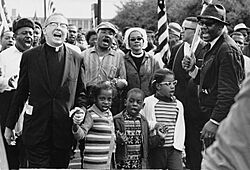
The group was later allowed into the Capitol. But they were told that Governor Wallace's office was closed for the day. The group left without being able to give their petition to anyone. The petition said:
We have come not only five days and fifty miles but we have come from three centuries of suffering and hardship. We have come to you, the Governor of Alabama, to declare that we must have our freedom now. We must have the right to vote; we must have equal protection of the law and an end to police brutality.
—Selma to Montgomery marchers petition
These steps are still the same as they were in 1965. Some repairs were made during the 1992 renovation. The steps have continued to be a place for protests over the years. Memorial Selma to Montgomery marches have ended at the steps many times. The most recent, honoring Martin Luther King Jr.'s 83rd birthday, was on January 15, 2012. On that day, Governor Robert J. Bentley greeted the marchers.
The steps have also seen protests by LGBT groups and immigration groups recently. A vigil for victims of hate and violence was held on the Capitol steps on February 20, 2011. This was to raise awareness about the lack of laws to protect LGBT people in the state. Hundreds of protesters gathered at the steps on December 17, 2011. They were protesting Alabama's strict new immigration law, Alabama HB 56.
Confederate Memorial Monument
Avenue of Flags
The Avenue of Flags is another important part of the Capitol grounds. It has flags from all the flags of the U.S. states. There's a native stone from each state, with its name carved on it, at the base of each flagpole. The flagpoles are in a half-circle shape. They are between the Capitol building's south wing and Washington Avenue. This area was finished when Governor Albert Brewer was in office. It was officially opened on April 6, 1968.
Visiting the Capitol
Areas open for visitors include the main stair-hall, the old Governor's Office, the old State Supreme Court, the old Supreme Court Library, the rotunda, the old House of Representatives, and the old Senate Chamber. The Alabama Historical Commission takes care of the buildings and grounds.
See also
 In Spanish: Capitolio del estado de Alabama para niños
In Spanish: Capitolio del estado de Alabama para niños
- List of National Historic Landmarks in Alabama
- First White House of the Confederacy, across the street from the capitol building
- Virginia State Capitol, second and last capitol building of the Confederacy
- List of state and territorial capitols in the United States


